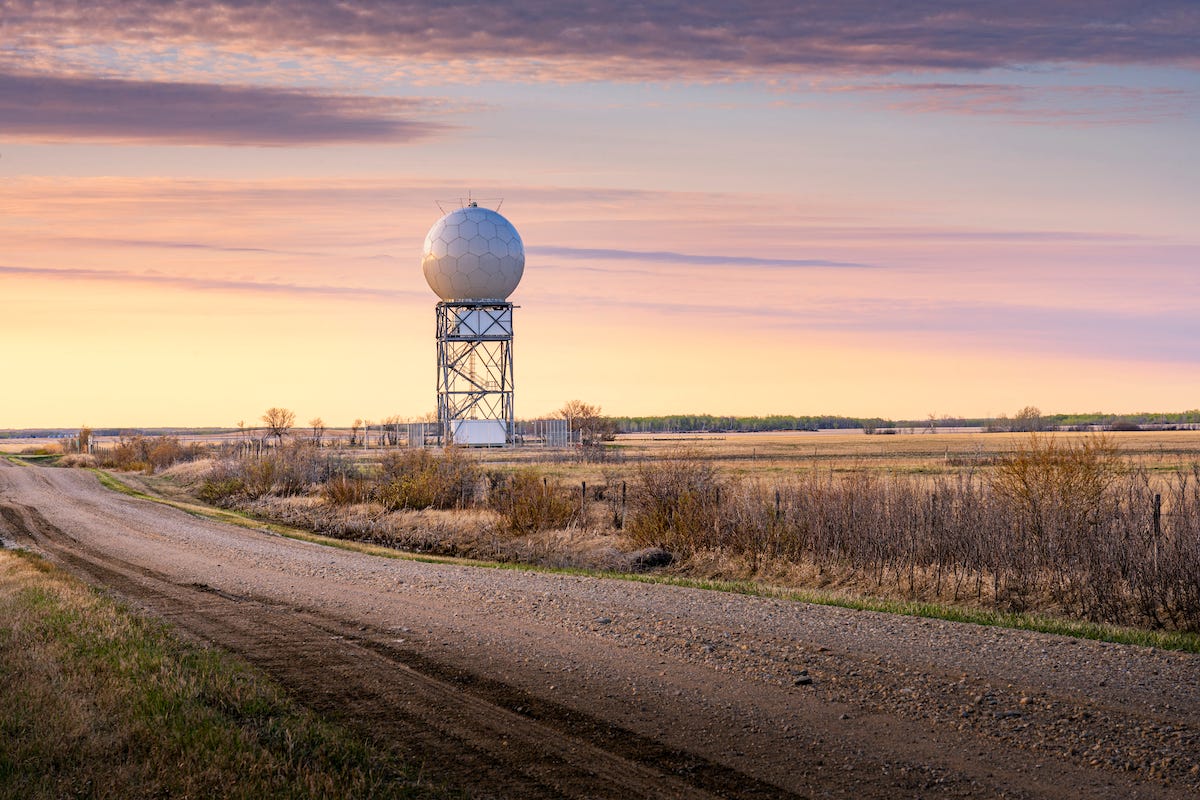We’re finally predicting the weather accurately
Widespread cheap sensors and advanced AI models portend ever better forecasts
So … how’s the weather? It’s one of the great diversionary questions, lest someone ask you for an opinion on striking Iran (right decision, wrong team for me) or a commentary on the Karen Read retrial (no opinion whatsoever). Of course, it’s not nearly as innocuous a query as it once was, given the intricacies of global climate disruption. In 2024, weather disasters reached $417 billion in damages across the world, with Hurricanes Helene and Milton clocking in at above $20 billion each. Estimates put the cost of Los Angeles’s wildfires early this year at between $76 billion and $131 billion, or roughly one-quarter of last year’s total global damages. In New York City, we’re cresting 100 degrees today on Primary Election Day, just one month after falling to an all-time low.
In short, it’s never been more vital to have better data and modeling around weather.
Despite the apparent ubiquity of ground radar, though, America’s weather infrastructure is decaying. According to a National Oceanic and Atmospheric Administration scientist, only roughly 70% of America’s population is covered by weather radar. America’s key equipment — the WSR-88D radar station — was last built in 1997, and there have been no new installations in a decade. (In fact, we are moving existing radar stations to try to compensate for missing coverage.) The situation has left the United States pockmarked by coverage gaps, affecting not only rural citizens who often are quite vulnerable, but also farms across the plains as well as airplanes flying across the country. They are living, growing and flying blind in an ever more disrupted world.
Thankfully, we are finally seeing expansive growth on the commercial weather side from startups that are bringing new technologies to bear on this age-old problem. Not unlike SpaceX’s Starlink satellites, these companies are rethinking weather modeling and prediction, eschewing the high costs of ground installations for more advanced, affordable and plentiful sensors that can be combined with frontier AI models to provide a clearer picture of the world as it really is.
Let’s start with prediction. Weather is notoriously finicky, and it’s not hard to understand why: earth’s climate system is mathematically chaotic, with small perturbations causing large changes in final outcomes. It’s not a fluke that the butterfly effect was coined about a butterfly flapping its wings in Africa and a hurricane appearing on the Eastern Seaboard.
Yet millions of butterflies are flapping their wings all the time, and we only got 11 hurricanes last year. Even in chaotic systems, there are features that dramatically limit randomness. Traditionally, meteorologists have used physics-based models run on some of the world’s fastest supercomputers. These days though, leading scientists are betting that artificial intelligence will provide a better alternative, since AI models can engorge on more information to potentially make much more accurate predictions.
It’s a competition that’s been an intensive area of study for many different research groups. Alphabet’s DeepMind published their GenCast weather prediction model in Nature last year, arguing that it outperformed traditional methods. Nvidia’s FourCastNet model and Huawei’s Pangu-Weather have also emerged as major new contenders. All of these models take advantage of global databases like ERA5, a massive weather dataset running back to 1940 compiled by the Copernicus Climate Change Service.
Outside better predictions, these models also expand the geographic scope of weather prediction. As Nicola Jones wrote in Yale Environment 360 a few weeks ago:
A.I. is spurring a revolution in the world of meteorology, allowing forecasts that once required huge teams of experts and massive supercomputers to be made on a laptop. Faster and cheaper forecast production means that poorer countries without their own government weather offices or supercomputer access should be able to produce their own custom forecasts.
By the list of company names, you can tell that the examples above are all mammoth-scale modeling endeavors. However, that’s not the only approach. Brightband, launched last September, wants to improve forecasting while also democratizing the field by providing open datasets and modeling tools to the general public. As the founders wrote at the time:
Unlike the traditional forecasts that are run by a small number of government agencies, Brightband provides access to anyone—from small to major organizations—to generate forecasts tailored to their unique needs. This means every forecaster gets superpowers to create customized weather forecasts and make informed decisions.
What matters to a farmer is very different from what matters to a pilot, an oil driller, a power grid maintenance worker or a road paver. Rather than reading the government’s single weather report and trying to translate its meaning into something useful, a properly-customized model could do that automatically, improving safety and efficiency for companies and workers.
These models are general-purpose and designed for day-to-day usage. Yet, climate change can also create novel disasters that these general models can’t fully handle. So over the last few years, we’ve seen the rise of a new generation of startups that are taking on specific disasters that can protect first responders and citizens alike.
Last week, one prominent company, Pano AI, announced a $44 million fundraise for its wildfire detection and forecasting platform. I first interviewed the founders while at TechCrunch back in 2021 as part of a series on technology and disaster response. Since then, the company has been on a tear. Its trick is the fusion of multiple forms of sensor data (including its own cameras to detect rising smoke in the wilderness) fed into an AI forecasting model that can quickly predict the outbreak of a wildfire and assist fire crews in rapidly responding. Wildfire growth is exponential, so a heads-up of even an extra few minutes or hours can dramatically limit the final damage.
As Pano indicates, we’re transitioning away from just radar stations to more holistic sensor platforms that can improve weather predictions. It’s a model that even works for the causes of some disasters as well. Gridware, another company I covered back in 2021, raised a $26.4 million Series A from Sequoia earlier this year to help power companies monitor their grids for irregularities. Its product has sensors for vibration, audio and other inputs that indicate damage to a grid (say, from a falling tree), and thanks to miniaturization, all of this is handled at the edge on-board their box. That makes it possible to fix problems before they spark large wildfires.
Collecting data from thousands of visible light and infrared cameras, microphones and vibration sensors wasn’t feasible until the massive expansion of computing over the past decade. But we aren’t even done with the number of new sensors available to stream information into next-generation AI models.
On the oceans, Lux’s own Saildrone offers autonomous unmanned vessels that can tack through hurricanes to offer real-time data from inside some of the greatest storms on Earth. While the company is much more heavily focused on the defense intelligence market these days, they’ve been a mainstay of NOAA’s drone fleet for years — that is, until last month, when cutbacks at the agency caused a widely-reported contracting flub that has roiled its operations. At least the Europeans get it: Saildrone raised $60 million last month, led by the Export and Investment Fund of Denmark, to improve the continent’s sovereignty over its intelligence data collection.
Europe also has its own homebrewed solutions. Finland-based Iceye is a company that specializes in and has installed the world’s largest constellation of synthetic aperture radar satellites, which can peer down to Earth 24 hours a day even through clouds. Like Saildrone’s ships, these types of satellites have multiple uses, including weather and defense. Iceye has recently specialized in battlefield intelligence for Ukraine, and its revenues have rapidly grown. The company said yesterday that it is looking toward an IPO in the near future.
We have one final new mode of sensor collection, and that’s balloons. Phileas Fogg may have raced to circumnavigate the globe in a hot-air balloon in 80 days, but now, the goal is the opposite: to park stationary balloons in the stratosphere to collect high-quality weather data over extended periods of time. One may recall the errant Chinese “weather balloon” that navigated the United States in early 2023 that I covered in “Balancing Balloons.” That one wasn’t very stationary!
Hopefully, these new balloons are friendlier, and there will be a lot more of them. Sorcerer announced that it raised a $3.9 million seed out of its YC batch earlier this month to deploy ultra-light weather balloons that can collect basic data like wind speed, humidity and pressure. Like Starlink, the hope here is that cheap quantity beats expensive quality when it comes to data sources, and that AI forecasting models could potentially ingest data from thousands of Sorcerer’s balloons into a coherent picture of the weather.
Asking about the weather may be the most basic form of small talk we have in our repertoire, but the weather is anything but a staid field. In fact, it’s one of the most dynamic areas of scientific and technological advancement. It’s also an area that has seen almost no revolutionary improvements, but rather a constant stream of evolutionary improvements that make the enterprise ever better. As Jones of Yale Environment 360 put it:
Though people tend to make fun of the reliability of weather forecasts, they have gotten very good over the past 50 years. In general, says [Peter Dueben, a model developer at European Centre for Medium-Range Weather Forecast], they’re improving about a day per decade: In other words, today’s six-day forecast is as accurate as the five-day forecast was 10 years ago.
No one heralds this. This isn’t a bunker buster descending through the skies and wiping out a threatening nation’s nuclear weapons program. But if you eat cheaper food, fly on a plane with less turbulence, or just avoid getting soaked outside, there are thousands of bright minds who have worked tirelessly to make our days incrementally better. The field calls it a “quiet revolution,” but really, shouldn’t such a radical improvement hit us like a thunderbolt?







